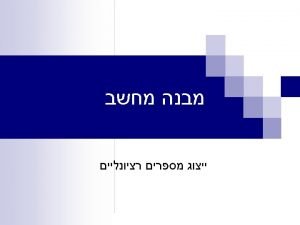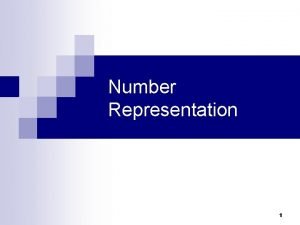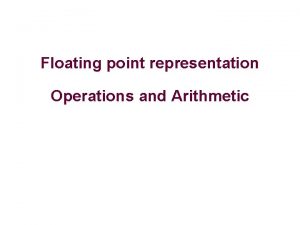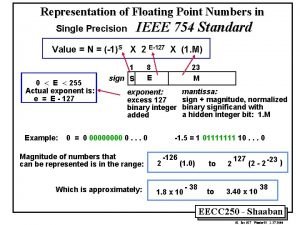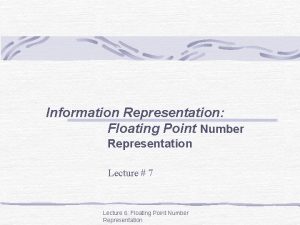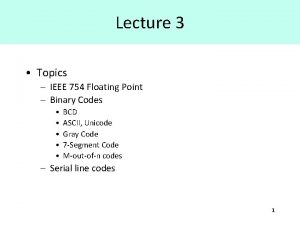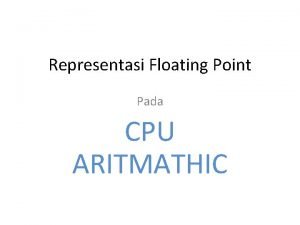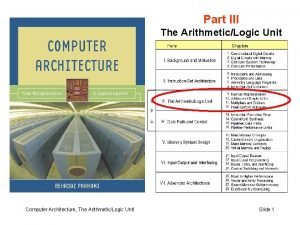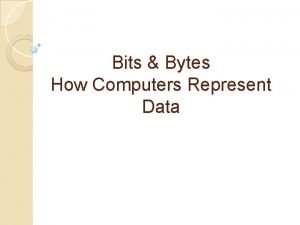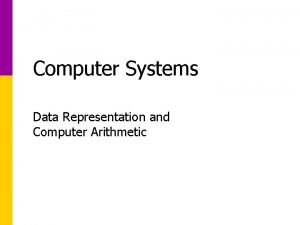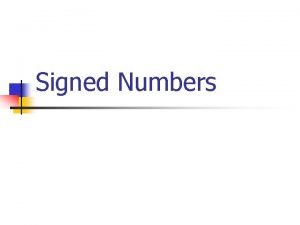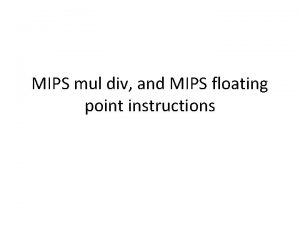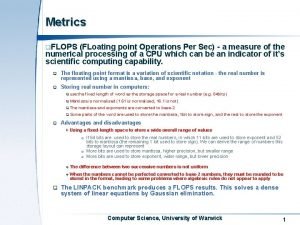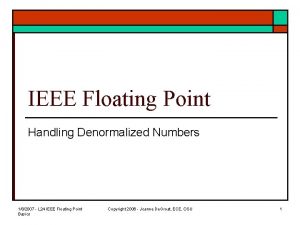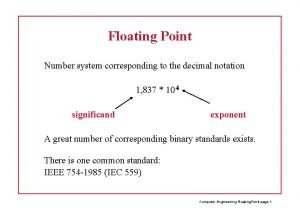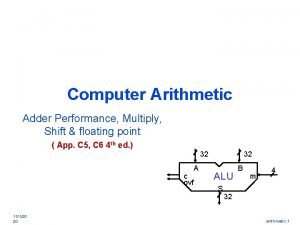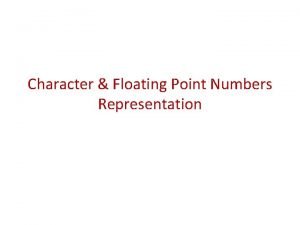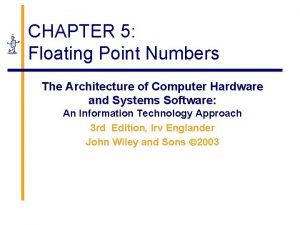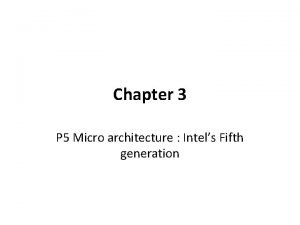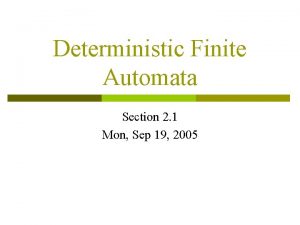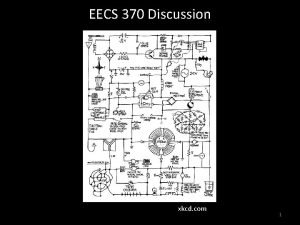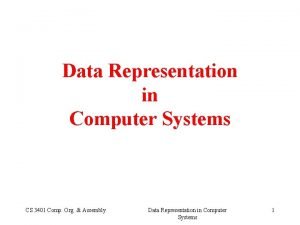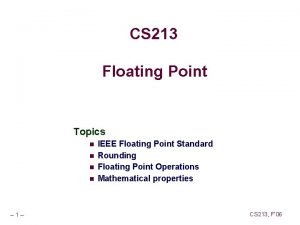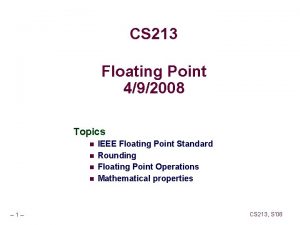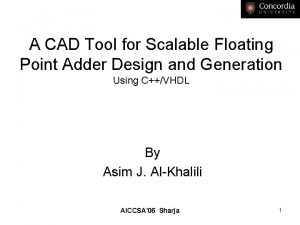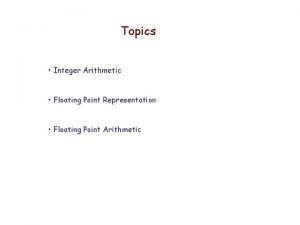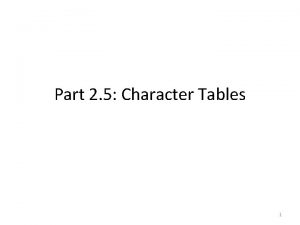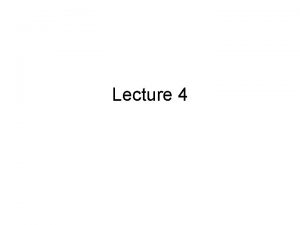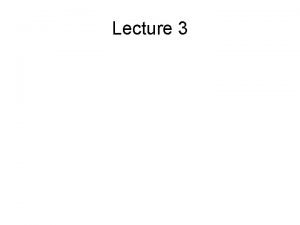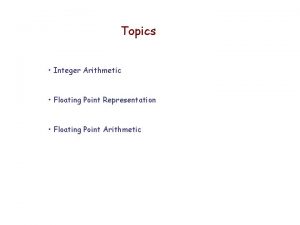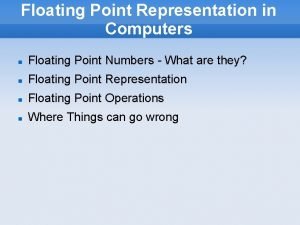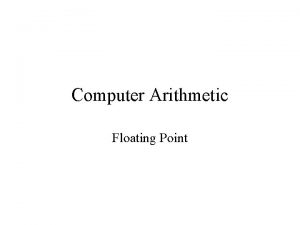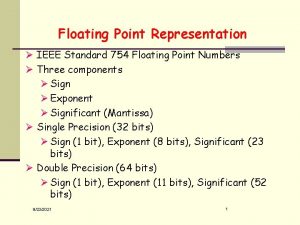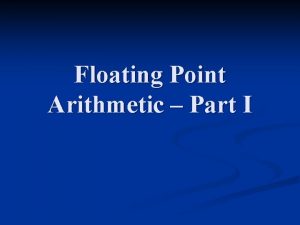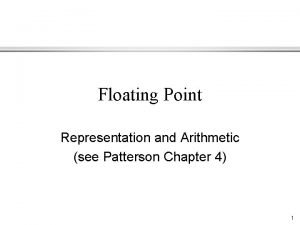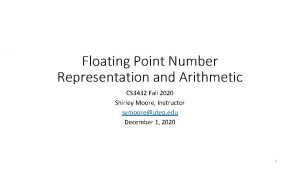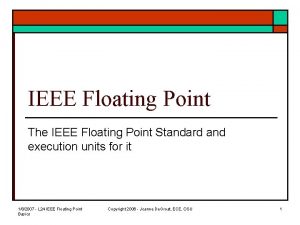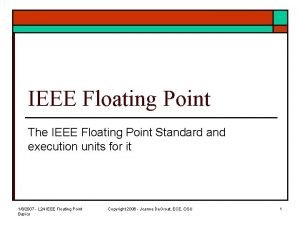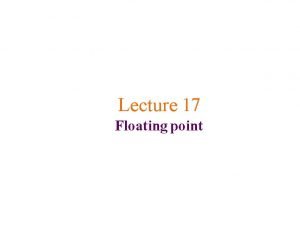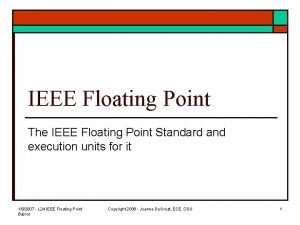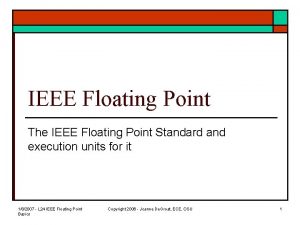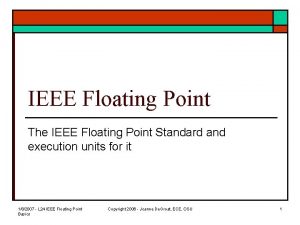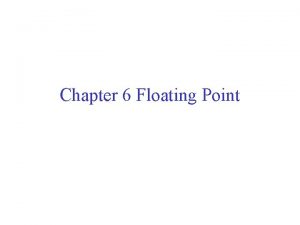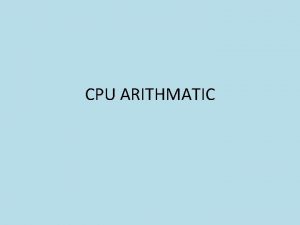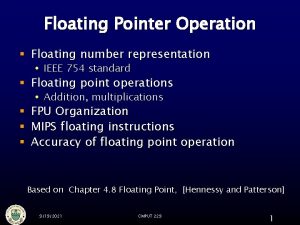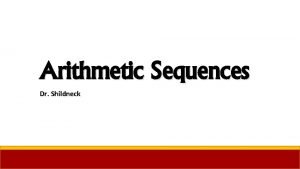Arithmetic for Computers Floating Point Representation for nonintegral
















































- Slides: 48

Arithmetic for Computers

Floating Point • Representation for non-integral numbers • Including very small and very large numbers • Like scientific notation normalized • – 2. 34 × 1056 • +0. 002 × 10– 4 not normalized 9 • +987. 02 × 10 • In binary • ± 1. xxxxxxx 2 × 2 yyyy • Types float and double in C

Floating Point Standard • Defined by IEEE Std 754 -1985 • Developed in response to divergence of representations • Portability issues for scientific code • Now almost universally adopted • Two representations • Single precision (32 -bit) • Double precision (64 -bit)

IEEE Floating-Point Format single: 8 bits double: 11 bits S Exponent single: 23 bits double: 52 bits Fraction • S: sign bit (0 non-negative, 1 negative) • Normalize significand: 1. 0 ≤ |significand| < 2. 0 • Always has a leading pre-binary-point 1 bit, so no need to represent it explicitly (hidden bit) • Significand is Fraction with the “ 1. ” restored • Exponent: excess representation: actual exponent + Bias • Ensures exponent is unsigned • Single: Bias = 127; Double: Bias = 1203

Single-Precision Range • Reserved exponents: • 0000 (to represent ± 0) • 1111 (± ∞ , Na. N) • Smallest value • Exponent: 00000001 actual exponent = 1 – 127 = – 126 • Fraction: 000… 00 significand = 1. 0 • ± 1. 0 × 2– 126 ≈ ± 1. 2 × 10– 38 • Largest value • exponent: 11111110 actual exponent = 254 – 127 = +127 • Fraction: 111… 11 significand ≈ 2. 0 • ± 2. 0 × 2+127 ≈ ± 3. 4 × 10+38

Excess notation for exponents If k = number of bits, notation is known as an excess (2 k-1 ) notation. For IEEE 754 format single-precision, k=8 excess 128 notation. If a number has exponent e, it is represented as (offset+(e) ) e. g. , e=-2, is represented as = 3+(-2) = 1 = 001 e=1 is represented as (offset+1) = 4 = 100. if k=3 excess 4 (23 -1 ) notation, 000 reserved (to represent ± 0) 001 (1) exponent = -2 (smallest (-23 -1 - 2)) 010 (2) exponent = -1 011 (3) exponent = 0 offset 100 (4) exponent = 1 101 (5) exponent = 2 110 (6) exponent = 3 (largest = 23 -1 - 1) 111 reserved (± ∞ , Na. N)

Excess notation • Smallest value • Exponent: 000001 actual exponent = 1 – 1023 = – 1022 • Fraction: 000… 00 significand = 1. 0 • ± 1. 0 × 2– 1022 ≈ ± 2. 2 × 10– 308 • Largest value • Exponent: 111110 actual exponent = 2046 – 1023 = +1023 • Fraction: 111… 11 significand ≈ 2. 0 • ± 2. 0 × 2+1023 ≈ ± 1. 8 × 10+308

Double-Precision Range • Reserved exponents: 0000… 00 (= 0) and 1111… 11 (= Na. N or ∞) • Smallest value • Exponent: 000001 actual exponent = 1 – 1023 = – 1022 • Fraction: 000… 00 significand = 1. 0 • ± 1. 0 × 2– 1022 ≈ ± 2. 2 × 10– 308 • Largest value • Exponent: 111110 actual exponent = 2046 – 1023 = +1023 • Fraction: 111… 11 significand ≈ 2. 0 • ± 2. 0 × 2+1023 ≈ ± 1. 8 × 10+308

Floating-Point Precision • Relative precision • all fraction bits are significant • Single: approx 2– 23 • Equivalent to 23 × log 102 ≈ 23 × 0. 3 ≈ 6 decimal digits of precision • Double: approx 2– 52 • Equivalent to 52 × log 102 ≈ 52 × 0. 3 ≈ 16 decimal digits of precision

Floating-Point Example • Represent – 0. 75 • – 0. 75 = (– 1)1 × 1. 12 × 2– 1 • S = 1 • Fraction = 1000… 002 • Exponent = – 1 + Bias • Single: – 1 + 127 = 126 = 011111102 • Double: – 1 + 1023 = 1022 = 01111102 • Single: 1011111101000… 00 • Double: 101111101000… 00

Floating-Point Example • What number is represented by the single-precision float 11000000101000… 00 • S = 1 • Fraction = 01000… 002 • Exponent = 100000012 = 129 • x = (– 1)1 × (1 + 012) × 2(129 – 127) = (– 1) × 1. 25 × 22 = – 5. 0

Arithmetic for Computers • Operations on integers • Addition and subtraction • Multiplication and division • Dealing with overflow • Floating-point real numbers • Representation and operations

Integer Addition • Example: 7 + 6 n Overflow if result out of range n n Adding +ve and –ve operands, no overflow Adding two +ve operands n n Overflow if result sign is 1 Adding two –ve operands n Overflow if result sign is 0

Integer Subtraction • Add negation of second operand • Example: 7 – 6 = 7 + (– 6) +7: – 6: +1: 0000 … 0000 0111 1111 … 1111 1010 0000 … 0000 0001 • Overflow if result out of range • Subtracting two +ve or two –ve operands, no overflow • Subtracting +ve from –ve operand • Overflow if result sign is 0 • Subtracting –ve from +ve operand • Overflow if result sign is 1

Dealing with Overflow • Some languages (e. g. , C) ignore overflow • Use MIPS addu, addui, subu instructions • Other languages (e. g. , Ada, Fortran) require raising an exception • Use MIPS add, addi, sub instructions • On overflow, invoke exception handler • Save PC in exception program counter (EPC) register • Jump to predefined handler address • mfc 0 (move from coprocessor reg) instruction can retrieve EPC value, to return after corrective action

Arithmetic for Multimedia • Graphics and media processing operates on vectors of 8 -bit and 16 -bit data • Use 64 -bit adder, with partitioned carry chain • Operate on 8× 8 -bit, 4× 16 -bit, or 2× 32 -bit vectors • SIMD (single-instruction, multiple-data) • Saturating operations • On overflow, result is largest representable value • c. f. 2 s-complement modulo arithmetic • E. g. , clipping in audio, saturation in video

Multiplication • Start with long-multiplication approach multiplicand multiplier product 1000 × 1001 1000 0000 1001000 Length of product is the sum of operand lengths

Multiplication multiplicand multiplier product 1. 2. 3. 4. 0000 1001 0000 1000 Check rightmost bit of xplier If 1 add xcand to product xplier >> 1 xcand << 1 …. To get

Multiplication multiplicand multiplier product 0001 0000 1001 1. If xplier bit = 0 don’t add xcand to product 2. xplier >> 1 3. xcand << 1 …… to get …

Multiplication multiplicand multiplier product 0010 0000 1000 1. Xplier bit = 0 2. xcand << 1 xplier >> 1 …

Multiplication multiplicand multiplier product 0100 0000 1 0100 1000 1. Xplier bit = 1 2. xcand << 1 , add to product, 3. xplier >> 1 … (done)

Multiplication Hardware Initially 0

Multiplication Example (0010 * 0011) • Each step in an iteration handles one bit and takes 1 clock cycle each iteration = 3 clock cycles for 1 bit • 32 -bit multiplication = 32*3 ~ 100 clock cycles • +/- ops are 5 to 100 times more popular than * • Improvement: 1 clock cycle per iteration (bit)

Optimized Multiplier • Perform steps in parallel: add/shift, i. e. , (shift mcand & mplier) in parallel with (mcand + mplier) • Multiplier placed in right half of Product register • Multiplicand in left half n One cycle per partial-product addition n That’s ok, if frequency of multiplications is low

Example Product register at the beginning: xplier 1001 (9) 0000 0101 (product) × 0101 (5) Add mcand to left half? Add xcand srl xcand/xpleir 1001 0000 0101 1001 0100 1010 0000 0100 1010 0010 0101 1001 0010 0101 1011 0101 1010 0000 0101 1010 0010 1101 0101101 (45) if xplierbit == 1, prod += mcand prod = prod >> 1 (just shift if xplier = 0)

Example: 2 * 3 = 0010 * 0011 Multiplicand = 0010 Xplier = 0011 Product register: 0000 0011 have to add mcand to left half of Prod register = 0010 0011 right shift entire Product register to get = 0001 (one (+ half) clock cycle) Next clock cycle to handle next bit: 0001 add mcand to left half of Prod register to get 0011 0001 right shift entire Product register to get 0001 1000 (one (+ half) clock cycle); since last two bits Since last two bits = 0: 0000 0110 right shift two bits. Done.


Booth’s Algorithm 25 24 23 22 21 20 0 1 1 1 0 0 = 28 Power j at beg. of run 1’s; Power k at End of run of 1’s Value = 2 j+1 – 2 k For example above: j = 4 and k = 2 Value = 24+1 – 22 = 32 – 4 = 28 If multipler has runs of 1’s: Replace with 1 addition and 1 substraction

Booth’s Algorithm 25 24 23 22 21 20 0 1 1 1 0 0 = 54 Beg. of run 1’s; End of run of 1’s How do you know where the beg/end of a run is? -- Look at the previous bit Take 25 – 22 = 32 – 4 = 28 If multipler has runs of 1’s: Replace with 1 addition and 1 substraction So, look for runs of 1’s in multiplier.

Booth’s Algorithm (multiple runs of 1’s) 26 25 24 23 22 21 20 0 1 1 0 = 54 Beg. of run 1’s; End of run of 1’s How do you know where the beg/end of a run is? -- Look at the previous bit Take 26 – 24 = 64 – 16 = 48 and 23 – 21 = 8 – 2 = 6 48 + 6 = 54

Booth’s Algorithm End of run Beginning of run

Example: 11 * 6 = 66 = 1000010 (11) 0000 1011 (6) 0000 0110 32 1 0 0000 1110 0000 0101 0100 0000 1010 0000 1000 0010 left shift amount # 00 0’s sll xcand 0 bits = NOP # 10 negate xcand (2’s comp) & sll 1 bit # 11 0’s sll xcand 1 bit = NOP (run of 1’s) # 01 sll xcand 1 bit and add # = 66 1110 = 0000 1011 = (1111 0100)toggled+ 1 (2’s complement) = 1111 0101 = 1110 1010 left shifted 1 bit

Faster Multiplier • Uses multiple adders • Cost/performance tradeoff n Can be pipelined n Several multiplication performed in parallel

MIPS Multiplication • Two 32 -bit registers for product • HI: most-significant 32 bits • LO: least-significant 32 -bits • Instructions • mult rs, rt / multu rs, rt • 64 -bit product in HI/LO • mfhi rd / mflo rd • Move from HI/LO to rd • Can test HI value to see if product overflows 32 bits • mul rd, rs, rt • Least-significant 32 bits of product –> rd

Division quotient dividend divisor 1001 1000 1001010 -1000 10 remainder n-bit operands yield n-bit quotient and remainder • Check for 0 divisor • Long division approach • If divisor ≤ dividend bits (remainder) • 1 bit in quotient, subtract • Otherwise • 0 bit in quotient, bring down next dividend bit • Restoring division • Do the subtract, and if remainder goes < 0, add divisor back • Signed division • Divide using absolute values • Adjust sign of quotient and remainder as required

Division Quotient Remainder Divisor Remainder 1001 1000 1001010 -1000000 0001010 100000 001010 -1000 10 • Quotient << 1 & add 1 if reminder >=0 • Divisor >> 1 (left half) after subtraction • Remainder = dividend after subtract Loop for all 32 bits: { Remainder = Remainder -Divisor if Remainder < 0 Remainder += Divisor; # restore Quotient << 1 and replace LSB = 0 else Quotient << 1 and replace LSB = 1 Divisor >> 1; }

Initially divisor in left half Initially dividend

Optimized Divider • One cycle per partial-remainder subtraction • Looks a lot like a multiplier! • Same hardware can be used for both

Faster Division • Can’t use parallel hardware as in multiplier • Subtraction is conditional on sign of remainder • Faster dividers • e. g. , Sweeney, Robertson, and Tocher (SRT) division determines quotient (lookup table) based on divisor and dividend. • Still require multiple steps

MIPS Division • Use HI/LO registers for result • HI: 32 -bit remainder • LO: 32 -bit quotient • Instructions • div rs, rt / divu rs, rt • No overflow or divide-by-0 checking • Software must perform checks if required • Example div $s 0, $s 1 quotient mfhi $t 0 mflo $t 1 # Hi contains the remainder, Lo contains # remainder moved into $t 0 # quotient moved into $t 1 The mult, div, mfhi, mflo are all R format instructions.

Floating-Point Addition • Consider a 4 -digit decimal example • 9. 999 × 101 + 1. 610 × 10– 1 • 1. Align decimal points • Shift number with smaller exponent • 9. 999 × 101 + 0. 016 × 101 • 2. Add significands • 9. 999 × 101 + 0. 016 × 101 = 10. 015 × 101 • 3. Normalize result & check for over/underflow • 1. 0015 × 102 • 4. Round and renormalize if necessary • 1. 002 × 102

Floating-Point Addition • Now consider a 4 -digit binary example • 1. 0002 × 2– 1 + – 1. 1102 × 2– 2 (0. 5 + – 0. 4375) • 1. Align binary points • Shift number with smaller exponent • 1. 0002 × 2– 1 + – 0. 1112 × 2– 1 • 2. Add significands • 1. 0002 × 2– 1 + – 0. 1112 × 2– 1 = 0. 0012 × 2– 1 • 3. Normalize result & check for over/underflow • 1. 0002 × 2– 4, with no over/underflow • 4. Round and renormalize if necessary • 1. 0002 × 2– 4 (no change) = 0. 0625

FP Adder Hardware • Much more complex than integer adder • Doing it in one clock cycle would take too long • Much longer than integer operations • Slower clock would penalize all instructions • FP adder usually takes several cycles • Can be pipelined

Floating-Point Multiplication • Consider a 4 -digit decimal example • 1. 110 × 1010 × 9. 200 × 10– 5 • 1. Add exponents • For biased exponents, subtract bias from sum • New exponent = 10 + – 5 = 5 • 2. Multiply significands • 1. 110 × 9. 200 = 10. 212 × 105 • 3. Normalize result & check for over/underflow • 1. 0212 × 106 • 4. Round and renormalize if necessary • 1. 021 × 106 • 5. Determine sign of result from signs of operands • +1. 021 × 106

Floating-Point Multiplication • Now consider a 4 -digit binary example • 1. 0002 × 2– 1 × – 1. 1102 × 2– 2 (0. 5 × – 0. 4375) • 1. Add exponents • Unbiased: – 1 + – 2 = – 3 • Biased: (– 1 + 127) + (– 2 + 127) = – 3 + 254 – 127 = – 3 + 127 • 2. Multiply significands • 1. 0002 × 1. 1102 = 1. 1102 × 2– 3 • 3. Normalize result & check for over/underflow • 1. 1102 × 2– 3 (no change) with no over/underflow • 4. Round and renormalize if necessary • 1. 1102 × 2– 3 (no change) • 5. Determine sign: +ve × –ve • – 1. 1102 × 2– 3 = – 0. 21875

FP Adder Hardware Step 1 Step 2 Step 3 Step 4

FP Arithmetic Hardware • FP multiplier is of similar complexity to FP adder • But uses a multiplier for significands instead of an adder • FP arithmetic hardware usually does • Addition, subtraction, multiplication, division, reciprocal, square-root • FP integer conversion • Operations usually takes several cycles • Can be pipelined

Accurate Arithmetic • IEEE Std 754 specifies additional rounding control • Extra bits of precision (guard, round, sticky) • Choice of rounding modes • Allows programmer to fine-tune numerical behavior of a computation • Not all FP units implement all options • Most programming languages and FP libraries just use defaults • Trade-off between hardware complexity, performance, and market requirements
 Fixed point representation vs floating point
Fixed point representation vs floating point Number system
Number system Floating number
Floating number Floating point addition flowchart
Floating point addition flowchart Floating point number representation
Floating point number representation Floating point representation
Floating point representation Floating point single precision
Floating point single precision Aritmathic
Aritmathic Floating point representation definition
Floating point representation definition How do computers represent data
How do computers represent data Data representation and computer arithmetic
Data representation and computer arithmetic Fp adder
Fp adder Range of signed number
Range of signed number Mips mul vs mult
Mips mul vs mult Floating point operations per seconds
Floating point operations per seconds Ieee denormalized numbers
Ieee denormalized numbers Floating-point number
Floating-point number Floating point 32 bit
Floating point 32 bit Eascii
Eascii Parts of a floating point number
Parts of a floating point number Explain integer pipeline of pentium
Explain integer pipeline of pentium Xkcd floating point
Xkcd floating point Dfa for floating point numbers
Dfa for floating point numbers Eecs 370
Eecs 370 Express (32)10 in the revised 14-bit floating-point model
Express (32)10 in the revised 14-bit floating-point model Floating point form
Floating point form Floating point puzzles
Floating point puzzles Floating point puzzles
Floating point puzzles Compound adder
Compound adder Floating point division
Floating point division Decimal fixed point representation
Decimal fixed point representation Mulliken symbol for irreducible representations
Mulliken symbol for irreducible representations Symmetry character table exam
Symmetry character table exam Matrix representation of c3v point group
Matrix representation of c3v point group Formuö
Formuö Typiska novell drag
Typiska novell drag Tack för att ni lyssnade bild
Tack för att ni lyssnade bild Vad står k.r.å.k.a.n för
Vad står k.r.å.k.a.n för Varför kallas perioden 1918-1939 för mellankrigstiden?
Varför kallas perioden 1918-1939 för mellankrigstiden? En lathund för arbete med kontinuitetshantering
En lathund för arbete med kontinuitetshantering Underlag för särskild löneskatt på pensionskostnader
Underlag för särskild löneskatt på pensionskostnader Tidbok yrkesförare
Tidbok yrkesförare A gastrica
A gastrica Densitet vatten
Densitet vatten Datorkunskap för nybörjare
Datorkunskap för nybörjare Boverket ka
Boverket ka Mall för debattartikel
Mall för debattartikel Delegerande ledarstil
Delegerande ledarstil Nyckelkompetenser för livslångt lärande
Nyckelkompetenser för livslångt lärande
